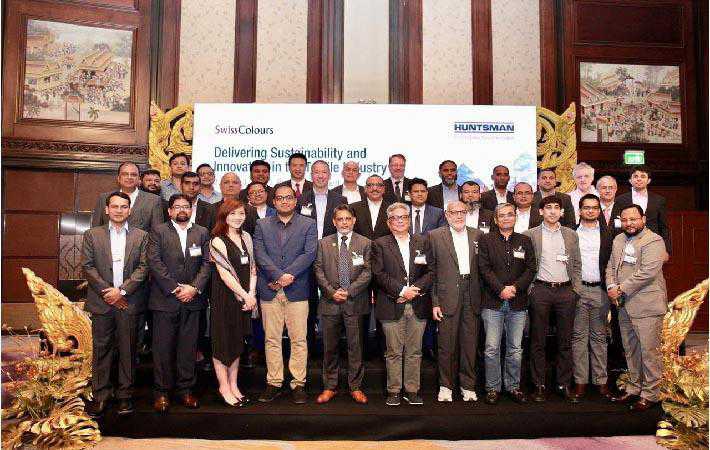Bangladesh invests in textile wet processing

The Huntsman Textile Effects and Swiss Colours Bangladesh team with some senior leaders and key decision makers ; Pic: Huntsman
More than 20 senior leaders from key Bangladeshi textile companies discussed challenges and opportunities in textile wet processing at a roundtable conference in Bangkok. The recent meeting provided a forum for business leaders to exchange ideas on how textile manufacturers in Bangladesh can improve their productivity and move up the value chain.
The meet jointly organised by Huntsman Textile Effects and Swiss Colours Bangladesh, was also an opportunity for the group to explore innovative new technologies and process innovations.
"As the long-term partner of Bangladesh's textile industry leaders, we are fully committed to driving sustainable solutions that are environmentally friendly and economically sound. We believe in collaboration and are pleased to be able to share our expertise and our technologies to help our customers produce higher value products from a cleaner and more efficient supply chain," Rohit Aggarwal, Huntsman Textile Effects president, said.
The roundtable also included a tour of Huntsman Textile Effect’s world-class manufacturing site at Mahachai, which is about 50 km outside the Thai capital. Participants saw how Huntsman’s high-quality reactive, wool and polyamide dyes and digital inks are produced and discussed environmental, health and safety (EHS) best practices with leaders at the site.
“Bangladesh is an important market for Huntsman Textile Effects and we work closely with our partner Swiss Colours to provide customised and innovative solutions for this market,” said Chuck Hirsch, vice president, commercial, at Huntsman Textile Effects. “Our aim is to enable our customers to stay at the forefront of industry trends and regulatory changes and create a more successful and sustainable textile industry in Bangladesh.”
The textile and ready-made garments (RMG) sector accounts for 84 per cent of the annual exports of Bangladesh, and downstream investment in textile processing is increasing to keep up with higher demand for high-quality dyed and printed fabric from local exporters. Price pressure in the sector remains intense, and costs are increasing as wages rise and mills make changes to meet stricter EHS standards and remove restricted chemicals from the supply chain. (RR)
Source:
Previous Story
- 6 Years After Rana Plaza Collapse, an Accord...
- Garment exports surge on US-China trade war
- Bangladesh And The Fire Next Time
- Australian brands should address worker issues: Oxfam
- Bangladesh: the Government challenges the Accord
- https://www.themds.com/markets/less-margin-for-fashion-bangladesh-puts-more-pressure-on-the-giants-of-the-sector.html
- H&M responds to sacking of Bangladesh garment workers,...
- Bangladesh suppliers to H&M, Next lay off workers...